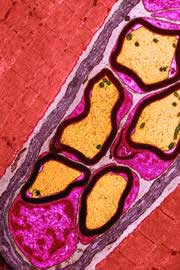Muscle is plastic fantastic

Some muscle cells are multi-talented. <br>© SPL <br>
American Society for Cell Biology Meeting, Washington, December 2001
Stem cells’ fates are a multiple choice.
A single stem cell from adult mouse muscle can form enough blood cells to save another animal’s life – and still switch back to making brawn, researchers announced at the Washington meeting of the American Society for Cell Biology this week.
Stem cells found in mashed up muscle can migrate into the bone marrow and make blood cells1. Muscle contains many different types of cell, however, and the exact identity of the one responsible remains unclear.
Johnny Huard, of the University of Pittsburgh in Pennsylvania, and his colleagues selected a group of adult mouse muscle cells that kept dividing for days and were marked by a distinct array of proteins.
When injected into mice whose bone marrow had been killed by radiation, the stem cells replaced it. Mice that would otherwise have died after 2 weeks survived for 6 months. And, when new blood stem cells were recovered and injected into a third mouse, they reverted to producing more muscle. This backtracking to their original job is the “most amazing thing”, says Huard.
“It shows that cells can go in many different directions given the right environment,” says stem-cell researcher Helen Blau of Stanford University in California. The traditional view – that stem cells progressively and permanently lose their initial ability to produce many cell types – is changing, she argues.
Rather than a one-way road of cell destiny, “It looks like a San Francisco highway”, says Blau. Stem cells can go off at one exit to make nerve cells and rejoin to make liver cells when the need arises.
Embryonic stem (ES) cells may still have properties that adult stem cells lack, cautions Ron McKay of the Memorial Sloan-Kettering Cancer Center in New York. Adult nerve stem cells are more likely to stop producing new nerve cells than are ES cells, he says, arguing for continued experimentation with the controversial human cells.
“I’ll say it because we’re in Washington: they [ES cells] grow without changing their developmental potential,” he says.
Muscling in
“We weren’t looking for stem cells,” explains Huard. He and his team were trying to find muscle cells that could restore the missing protein dystrophin in patients suffering from the wasting muscle disease Duchenne muscular dystrophy (DMD). They wanted cells that were tough enough to survive transplantation into a patient.
They injected their selected cell group, labelled so that they could be tracked, into mice with a form of DMD. But the cells rarely turned up in muscle. Instead, Huard found them in heart, liver, lung, spleen – but mainly bone marrow. “I got sidetracked,” he says.
Huard is now trying to coax his stem cells back to muscle by searching for the molecules that lure them there. Working muscle cells would bump up dystrophin levels. “It will be very exciting,” he predicts.
To finally identify the elusive muscle stem cell, researchers must start from a single cell, warns Blau: even Huard’s group of purified cells could contain outliers with unknown effects. Such a technique identified an ’ultimate’ stem cell from bone marrow earlier this year2.
References
- Jackson, K.A. et al. Hematopoietic potential of stem cells isolated from murine skeletal muscle. Proceedings of the National Academy of Science, 96, 14482 – 14486, (1999).
- Krause, D.S. et al. Multi-organ, multi-lineage engraftment by a single bone marrow-derived stem cell. Cell, 105, 369 – 377, (2001).
Media Contact
More Information:
http://www.nature.com/nsu/011213/011213-9.htmlAll latest news from the category: Life Sciences and Chemistry
Articles and reports from the Life Sciences and chemistry area deal with applied and basic research into modern biology, chemistry and human medicine.
Valuable information can be found on a range of life sciences fields including bacteriology, biochemistry, bionics, bioinformatics, biophysics, biotechnology, genetics, geobotany, human biology, marine biology, microbiology, molecular biology, cellular biology, zoology, bioinorganic chemistry, microchemistry and environmental chemistry.
Newest articles

Innovative 3D printed scaffolds offer new hope for bone healing
Researchers at the Institute for Bioengineering of Catalonia have developed novel 3D printed PLA-CaP scaffolds that promote blood vessel formation, ensuring better healing and regeneration of bone tissue. Bone is…

The surprising role of gut infection in Alzheimer’s disease
ASU- and Banner Alzheimer’s Institute-led study implicates link between a common virus and the disease, which travels from the gut to the brain and may be a target for antiviral…

Molecular gardening: New enzymes discovered for protein modification pruning
How deubiquitinases USP53 and USP54 cleave long polyubiquitin chains and how the former is linked to liver disease in children. Deubiquitinases (DUBs) are enzymes used by cells to trim protein…



